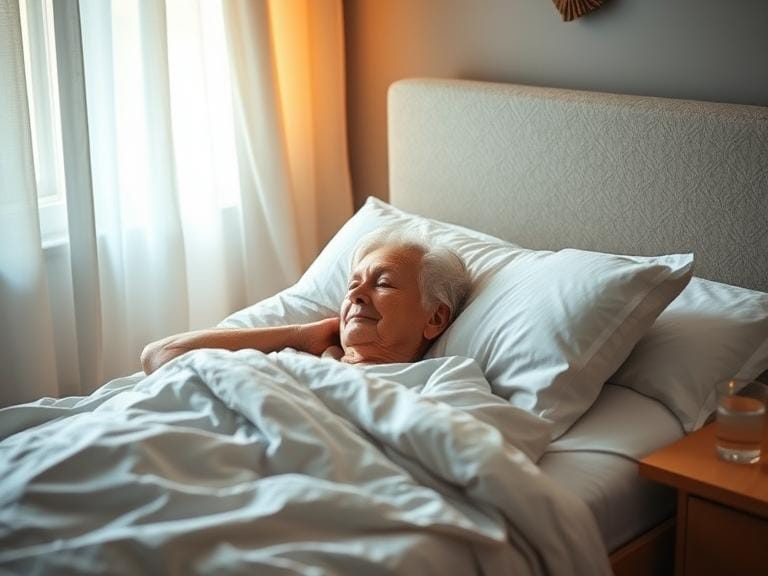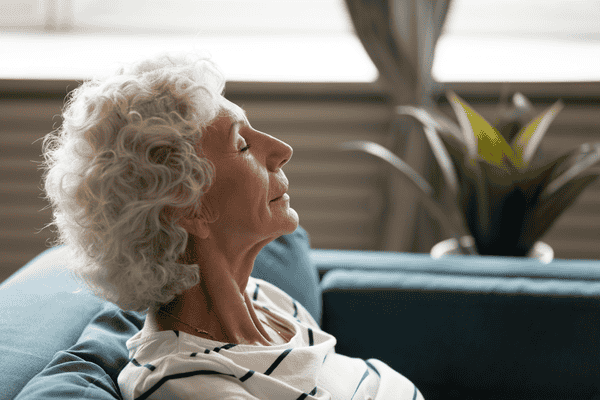When Sarah noticed her 72-year-old mother forgetting familiar recipes and struggling to follow conversations, she wondered if this was just “normal aging.” What she discovered surprised her: her mother was sleeping only four to five hours each night, tossing and turning with worry. After implementing simple sleep improvements over several months, Sarah watched her mother’s memory sharpen, her mood brighten, and her confidence return. This transformation wasn’t magic—it was the power of quality sleep working to protect an aging brain.
If you’re caring for an aging parent or loved one, you hold remarkable power to influence their long-term health and happiness. Research reveals that helping older adults achieve consistent, restorative sleep could significantly lower their risk of memory problems, cognitive decline, and even Alzheimer’s disease. This isn’t just about feeling rested; it’s about giving their brain the nightly maintenance it desperately needs to stay healthy as they age.
Throughout this guide, you’ll discover the vital connection between sleep and brain health, learn practical strategies you can implement starting today, and understand when professional help becomes necessary. Most importantly, you’ll see how your caring involvement can make the difference between gradual decline and thriving in later years.
Why Quality Sleep Acts as Your Loved One’s Brain Protection System
Every night while your loved one sleeps, their brain performs an extraordinary housekeeping operation that you can’t see but absolutely must support. During deep sleep phases, the brain’s glymphatic system activates like a sophisticated cleaning crew, washing away harmful proteins that accumulate during waking hours. Among these proteins is amyloid-beta, a sticky substance that clumps together in the brains of people with Alzheimer’s disease. When sleep is consistently poor or insufficient, this crucial cleaning process becomes less effective, allowing dangerous buildups that can damage memory and thinking abilities over time.
The research tells a concerning story about sleep duration extremes. Adults who regularly sleep six hours or less face significantly higher risks of cognitive decline, memory loss, and poor decision-making abilities. Surprisingly, sleeping more than nine hours nightly also correlates with increased Alzheimer’s risk, suggesting that both too little and too much sleep can signal or contribute to brain health problems. The sweet spot appears to be seven to eight hours of quality sleep, which provides optimal time for brain restoration without the complications associated with excessive sleep duration.
Think of sleep as your loved one’s nightly insurance policy against cognitive decline. Just as you wouldn’t skip regular maintenance on a valuable car, the brain requires consistent, quality sleep maintenance to function optimally throughout the aging process. When you help establish healthy sleep patterns, you’re essentially investing in their future independence, memory preservation, and overall quality of life. This investment pays dividends not just in brain health, but in mood stability, physical strength, and the ability to enjoy meaningful relationships and activities.
Creating the Foundation: Sleep-Friendly Routines That Actually Work
Establishing Consistent Sleep Schedules
The human body thrives on predictability, and this becomes even more crucial as we age. Your loved one’s internal clock, or circadian rhythm, can become less reliable over time, making external structure increasingly important. Start by helping them establish a consistent bedtime and wake-up time that allows for seven to eight hours of sleep. For example, if they naturally feel tired around 9 PM, encourage a 9 PM to 6 AM schedule rather than fighting their natural tendencies.
Consistency means seven days a week, not just weekdays. I remember working with Margaret, whose sleep improved dramatically once we stopped letting her “sleep in” on weekends. Initially, she resisted the early weekend wake-ups, but within three weeks, she was falling asleep more easily and feeling more energetic during the day. The key is gentle persistence and helping them understand that their brain actually craves this predictability.
Napping presents a particular challenge that requires careful management. While a brief 20 to 30-minute rest in the early afternoon can be refreshing, longer naps or late-day sleeping can steal precious sleep drive needed for nighttime rest. Help your loved one recognize the difference between feeling tired (which might call for gentle activity) and feeling genuinely sleepy (which might indicate a need for a brief, well-timed nap). When naps become necessary, set a gentle alarm and encourage them to rest in a chair rather than bed to avoid accidentally sleeping too long.
Designing a Sleep Sanctuary
The bedroom environment powerfully influences sleep quality, yet it’s often overlooked in favor of more complex interventions. Your loved one’s bedroom should feel like a peaceful retreat that signals to their brain that it’s time to rest and restore. Start with lighting, as aging eyes become more sensitive to light disruption. Install blackout curtains or shades that block streetlights and early morning sun. Even small amounts of light can interfere with melatonin production, the hormone that helps regulate sleep-wake cycles.
Temperature control matters more than many people realize. A slightly cool room, around 65 to 68 degrees Fahrenheit, supports the body’s natural temperature drop that occurs during sleep onset. If your loved one tends to feel cold, layer blankets rather than raising the room temperature, as overheating can cause frequent nighttime awakenings. Consider their comfort preferences while gently educating them about optimal sleep temperatures.
Sound management requires a personalized approach. Some older adults sleep better with complete silence, while others find gentle, consistent sounds more soothing than intermittent noise. A white noise machine can mask disruptive sounds like traffic or neighbor activity. For those who prefer quiet, soft earplugs designed for sleeping might help. The goal is creating an environment where unexpected sounds won’t jolt them awake, interrupting crucial deep sleep phases.
Encouraging Health-Promoting Daily Habits
Morning sunlight exposure acts like a natural reset button for the circadian rhythm, signaling to the brain that it’s time to be alert and active. Encourage your loved one to spend at least 15 to 20 minutes outside in natural light each morning, ideally within the first hour of waking. This doesn’t require intense exercise—a gentle walk around the yard, sitting on a porch with morning coffee, or tending to plants can provide the light exposure needed to strengthen their sleep-wake cycle.
Physical activity during the day significantly improves nighttime sleep quality, but timing and intensity matter. Gentle activities like stretching, gardening, swimming, or walking help tire the body in healthy ways while boosting mood-regulating chemicals. However, vigorous exercise within three hours of bedtime can be stimulating rather than relaxing. Help your loved one find activities they enjoy and can sustain, as consistency trumps intensity when it comes to sleep benefits.
The connection between daytime habits and nighttime rest extends beyond exercise and light. Social engagement, mental stimulation, and purposeful activities during waking hours contribute to better sleep satisfaction. When older adults feel fulfilled and appropriately challenged during the day, they’re more likely to experience the deep, restorative sleep their brains need for optimal functioning.
Practical Activities That Enhance Sleep Quality
Mastering Relaxation Techniques
Teaching your loved one effective relaxation techniques provides them with powerful tools for transitioning from the day’s stresses to peaceful sleep. Progressive muscle relaxation, where they systematically tense and then release different muscle groups, can be particularly effective for older adults who carry physical tension. Start with their toes, having them tense the muscles for five seconds, then release and notice the contrast. Move systematically up through legs, abdomen, arms, and face. This technique not only promotes physical relaxation but gives the mind a focused task that crowds out worrying thoughts.
Deep breathing exercises offer another accessible pathway to relaxation. Guide your loved one through the 4-7-8 technique: inhale through the nose for four counts, hold the breath for seven counts, then exhale through the mouth for eight counts. This pattern activates the parasympathetic nervous system, naturally slowing heart rate and promoting calm. Practice together during the day so the technique becomes familiar and easy to use at bedtime.
Many older adults respond well to guided meditation apps specifically designed for seniors, with slower pacing and age-relevant content. Apps like Calm or Insight Timer offer sleep-specific meditations that can help quiet racing thoughts. Sit with your loved one initially to help them navigate the technology and find preferred voices or styles. Some prefer nature sounds with gentle guidance, while others respond better to progressive relaxation scripts. The key is finding what resonates with their personal preferences and comfort level.
Eliminating Sleep Disruptors
Caffeine sensitivity often increases with age, meaning that afternoon coffee or tea can interfere with sleep even if it never caused problems before. Help your loved one establish a “caffeine curfew” of noon or 1 PM, encouraging herbal teas or warm milk in the evening instead. This transition can be challenging for lifelong coffee drinkers, so approach it gradually. Try reducing caffeine strength or switching to half-caffeinated blends before eliminating it entirely from afternoon routines.
Evening meals require careful timing and composition to support rather than hinder sleep. Large, heavy, or spicy meals within three hours of bedtime can cause discomfort and interfere with the body’s natural temperature regulation during sleep. If your loved one needs an evening snack, suggest light options like a small portion of nuts, a banana, or a piece of whole-grain toast with a thin spread of peanut butter. These foods contain natural compounds that may promote sleep without causing digestive disruption.
Screen time presents a particular challenge in our connected world, but the blue light emitted by phones, tablets, and televisions can suppress melatonin production. Encourage a “digital sunset” one hour before bedtime, replacing screen activities with reading, gentle conversation, puzzles, or listening to music. If your loved one relies on television for evening entertainment, consider moving the TV out of the bedroom and establishing a specific time for turning it off each night.
Monitoring Sleep Patterns and Recognizing Warning Signs
The Power of Sleep Tracking
Keeping a simple sleep diary provides invaluable insights into patterns that might not be obvious day to day. Help your loved one track basic information: what time they got into bed, how long it took to fall asleep, how many times they woke during the night, what time they woke up, and how rested they felt in the morning. After one to two weeks, patterns often emerge that point toward specific solutions.
Modern technology offers user-friendly options for sleep tracking, from simple smartphone apps to wearable devices designed for seniors. However, don’t let technology become a source of stress or obsession. The goal is gathering helpful information, not creating anxiety about sleep performance. Some older adults prefer a simple paper log by their bedside, while others enjoy the detailed feedback from sleep apps. Choose the method that fits their comfort level and technical abilities.
Look for patterns in the sleep diary that might reveal correctable issues. Does your loved one sleep better on days when they’ve been more physically active? Do certain foods or activities seem to correlate with poor sleep? Are there particular times of night when they consistently wake up? This information becomes extremely valuable when discussing sleep concerns with healthcare providers and can guide your efforts to make targeted improvements.
Recognizing Sleep Disorder Warning Signs
Sleep apnea becomes more common with age and can significantly impact both sleep quality and overall health. Watch for signs like loud snoring, gasping or choking sounds during sleep, excessive daytime sleepiness despite adequate time in bed, morning headaches, or difficulty concentrating. If your loved one sleeps alone, they might not be aware of nighttime breathing disruptions, making your observations crucial for early detection.
Restless leg syndrome, periodic limb movement disorder, and other sleep-related movement issues can fragment sleep without the person fully awakening. Signs might include complaints of “restless” sleep, tangled bedsheets in the morning, or unexplained daytime fatigue despite seemingly adequate sleep duration. These conditions are often treatable but require professional evaluation for proper diagnosis.
Changes in sleep patterns can also signal underlying health issues or medication side effects that need medical attention. Sudden onset of sleep difficulties, dramatic changes in usual sleep timing, or new complaints of chronic fatigue warrant professional evaluation. Sometimes sleep changes precede other symptoms of conditions like depression, anxiety, or even early cognitive decline, making early intervention particularly valuable.
Knowing When Professional Help Is Essential
Persistent sleep problems that don’t respond to behavioral changes within four to six weeks merit professional evaluation. A healthcare provider can assess for underlying medical conditions, review medications that might interfere with sleep, and recommend appropriate treatments. Sleep studies might be necessary to diagnose conditions like sleep apnea, which becomes increasingly common with age but is highly treatable when properly identified.
Don’t hesitate to seek help if sleep problems are affecting your loved one’s daytime functioning, mood, or safety. Signs that professional intervention is needed include falling asleep during conversations or activities, confusion or memory problems that seem worse than usual, increased falls or accidents, or significant mood changes like increased anxiety or depression. These symptoms might indicate that poor sleep is contributing to more serious health concerns.
When preparing for medical consultations, bring the sleep diary and any observations you’ve made about your loved one’s sleep patterns. Healthcare providers appreciate detailed information about what you’ve already tried and what specific concerns you’ve noticed. This preparation helps ensure that limited appointment time is used effectively and that all relevant issues are addressed.
Your Vital Role in Supporting Healthy Sleep
As an adult child or caregiver, your involvement in improving your loved one’s sleep extends far beyond implementing practical tips. You provide emotional support during what can be a vulnerable time, helping them understand that seeking better sleep isn’t admitting weakness but taking positive action for their health. Your encouragement and patience during the adjustment period can make the difference between successful habit changes and giving up when initial efforts don’t immediately show results.
Better sleep for your loved one creates positive ripple effects throughout your relationship and family dynamics. When older adults sleep well, they’re more likely to maintain their independence, engage meaningfully in family activities, and preserve the personality and cognitive abilities that make them uniquely themselves. The grandmother who sleeps better can follow complex conversations, remember family stories, and participate fully in holiday celebrations. The father who gets quality rest maintains better judgment, mood stability, and physical coordination that contribute to his safety and your peace of mind.
Your efforts to support healthy sleep also represent an investment in your own well-being as a caregiver. Older adults who sleep poorly often experience increased confusion, irritability, and physical health problems that create additional caregiving demands. By helping establish healthy sleep patterns now, you’re potentially reducing future caregiving stress while extending the period during which your loved one can live independently and maintain their quality of life.
The journey toward better sleep might require patience and persistence, but remember that even small improvements can yield significant benefits. Start with the changes that seem most manageable for your specific situation, whether that’s adjusting bedtime routines, improving the sleep environment, or encouraging more daytime activity. Success builds on success, and as your loved one begins to experience better sleep, they’re likely to become more motivated to maintain and expand healthy sleep habits.
Taking the First Step Toward Better Sleep
Quality sleep represents one of the most powerful, accessible tools for protecting brain health and supporting successful aging. The seven to eight hours your loved one spends sleeping each night aren’t passive time—they’re active investment in cognitive preservation, mood stability, and overall health. Every night of improved sleep contributes to the brain’s ability to clear harmful proteins, consolidate memories, and maintain the neural connections that support thinking, learning, and emotional well-being.
The strategies outlined in this guide aren’t theoretical concepts but practical approaches that thousands of families have used successfully to improve sleep and quality of life for their aging loved ones. From establishing consistent routines to creating optimal sleep environments, from teaching relaxation techniques to recognizing when professional help is needed, these tools provide a comprehensive framework for supporting healthy sleep throughout the aging process.
Begin today with one small change that feels manageable in your specific situation. Perhaps it’s encouraging a morning walk together, helping adjust the bedroom temperature, or simply starting a conversation about sleep quality and its importance. As you implement these changes, remember that you’re not just helping your loved one sleep better—you’re actively participating in protecting their cognitive health, preserving their independence, and ensuring that the years ahead can be filled with meaningful connections, cherished memories, and the joy that comes from aging well.
Your commitment to supporting better sleep is truly a gift that keeps giving, benefiting not only your loved one’s brain health but strengthening the bonds between you and creating more opportunities for the relationships and experiences that make life meaningful at any age.





